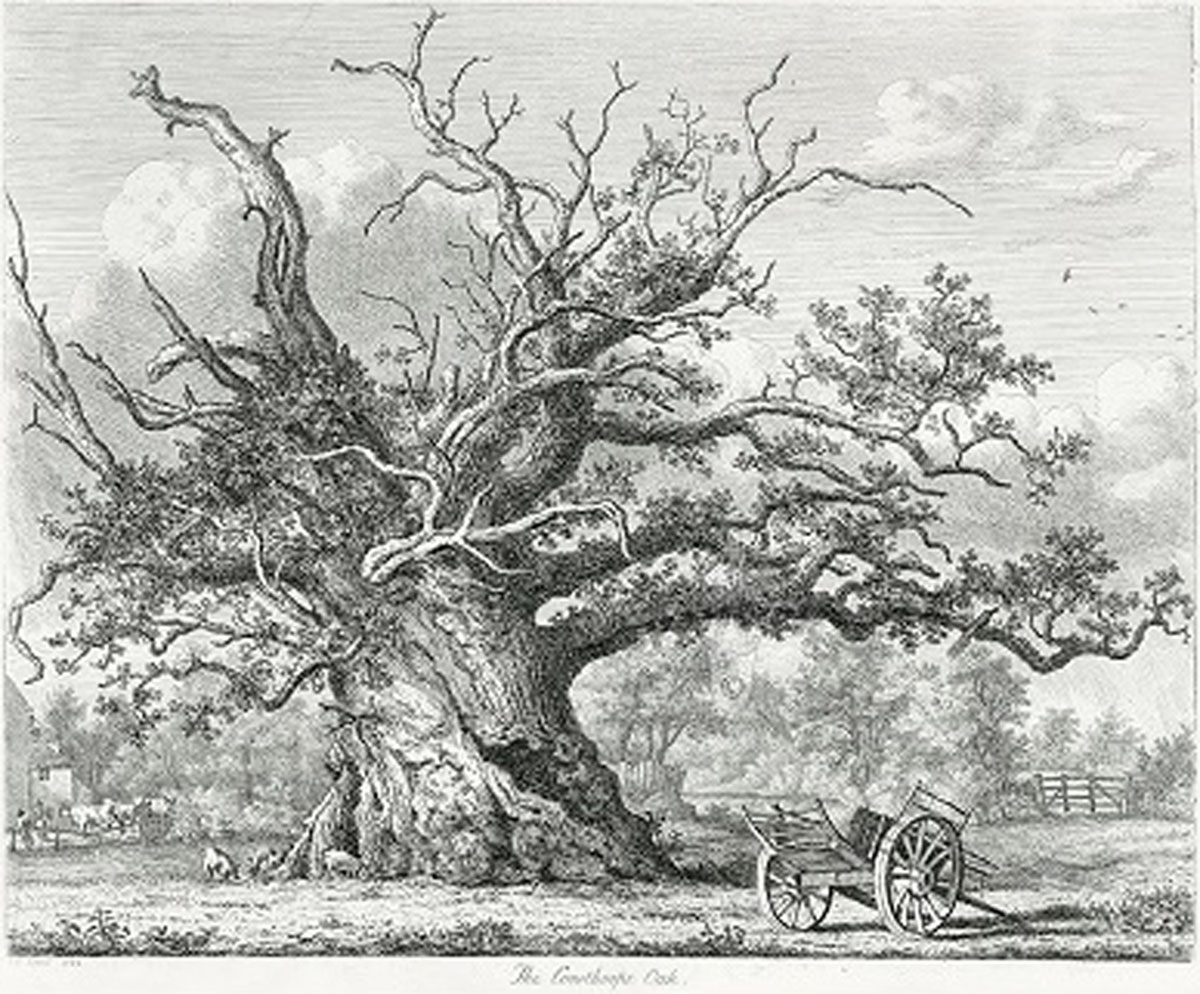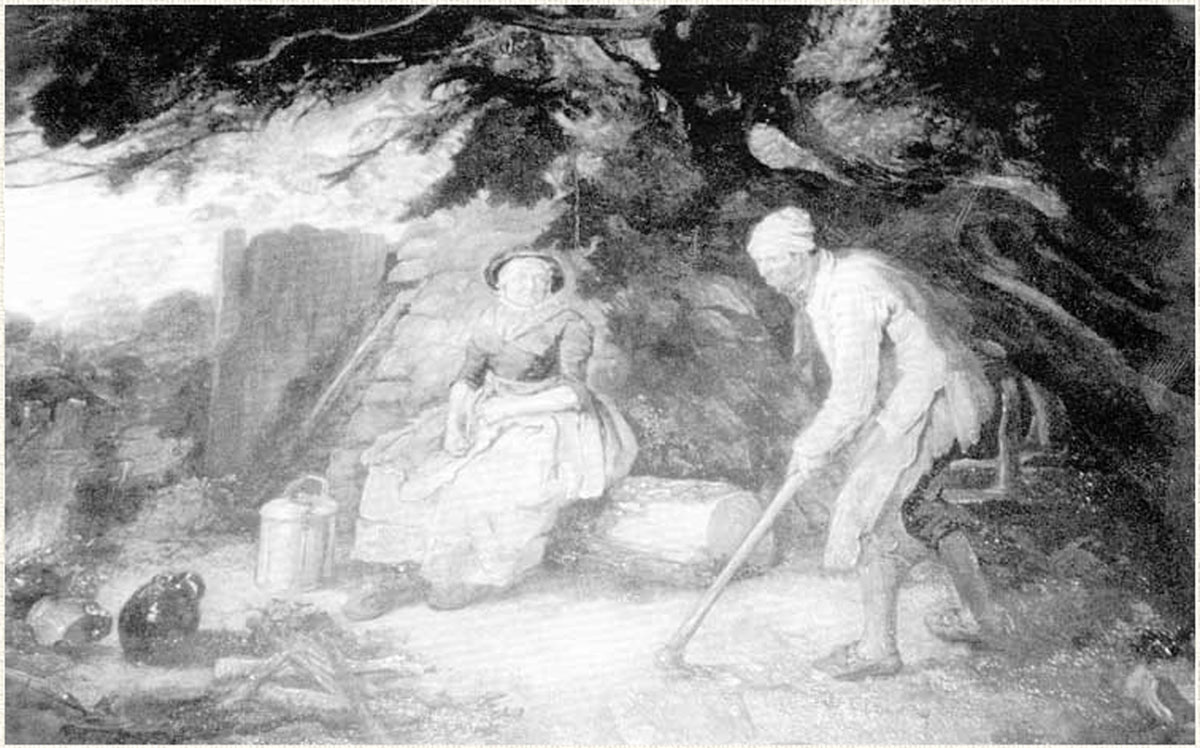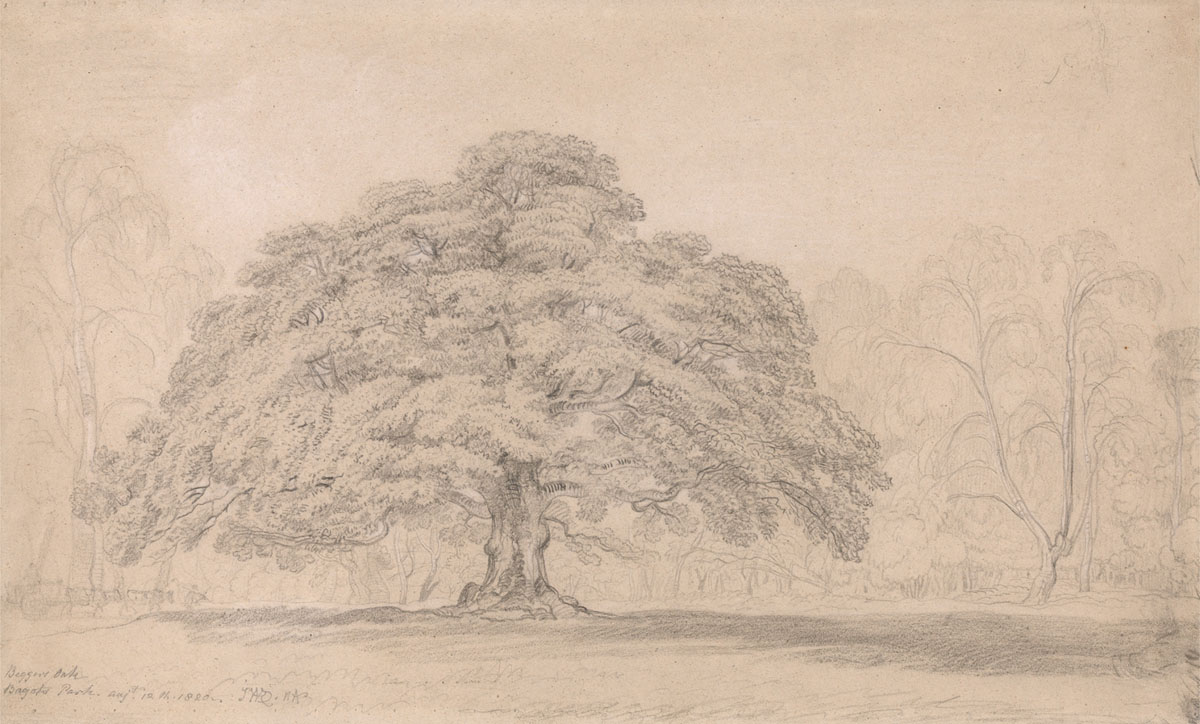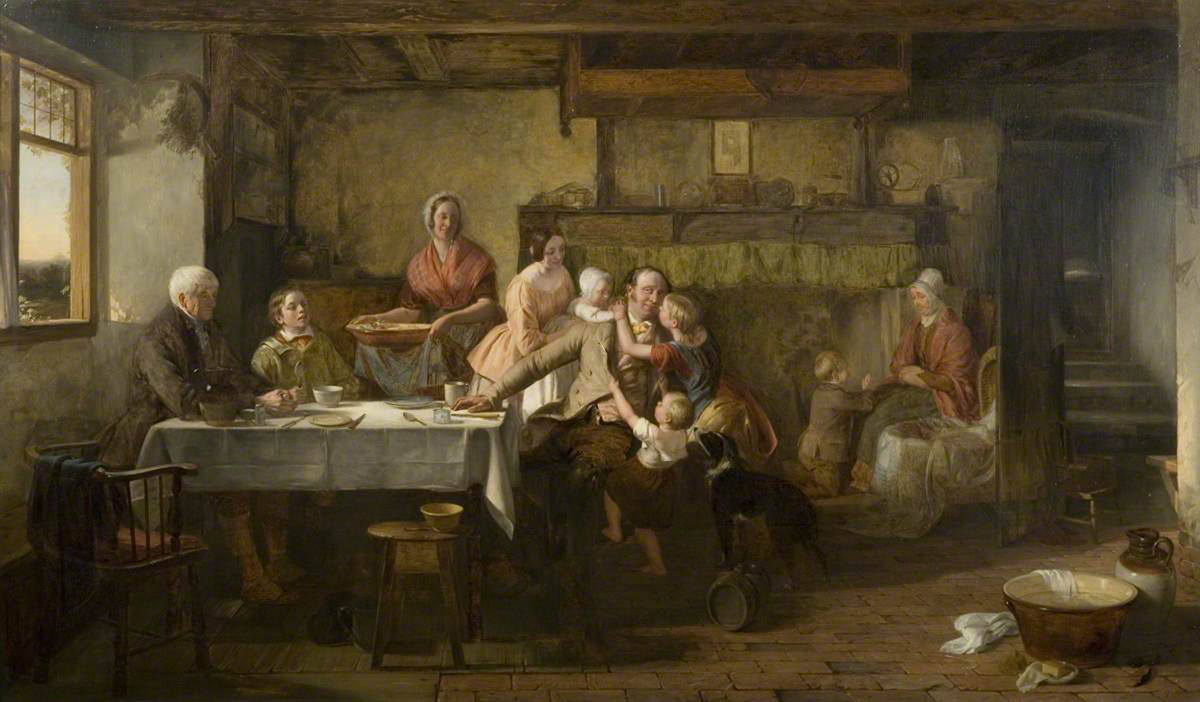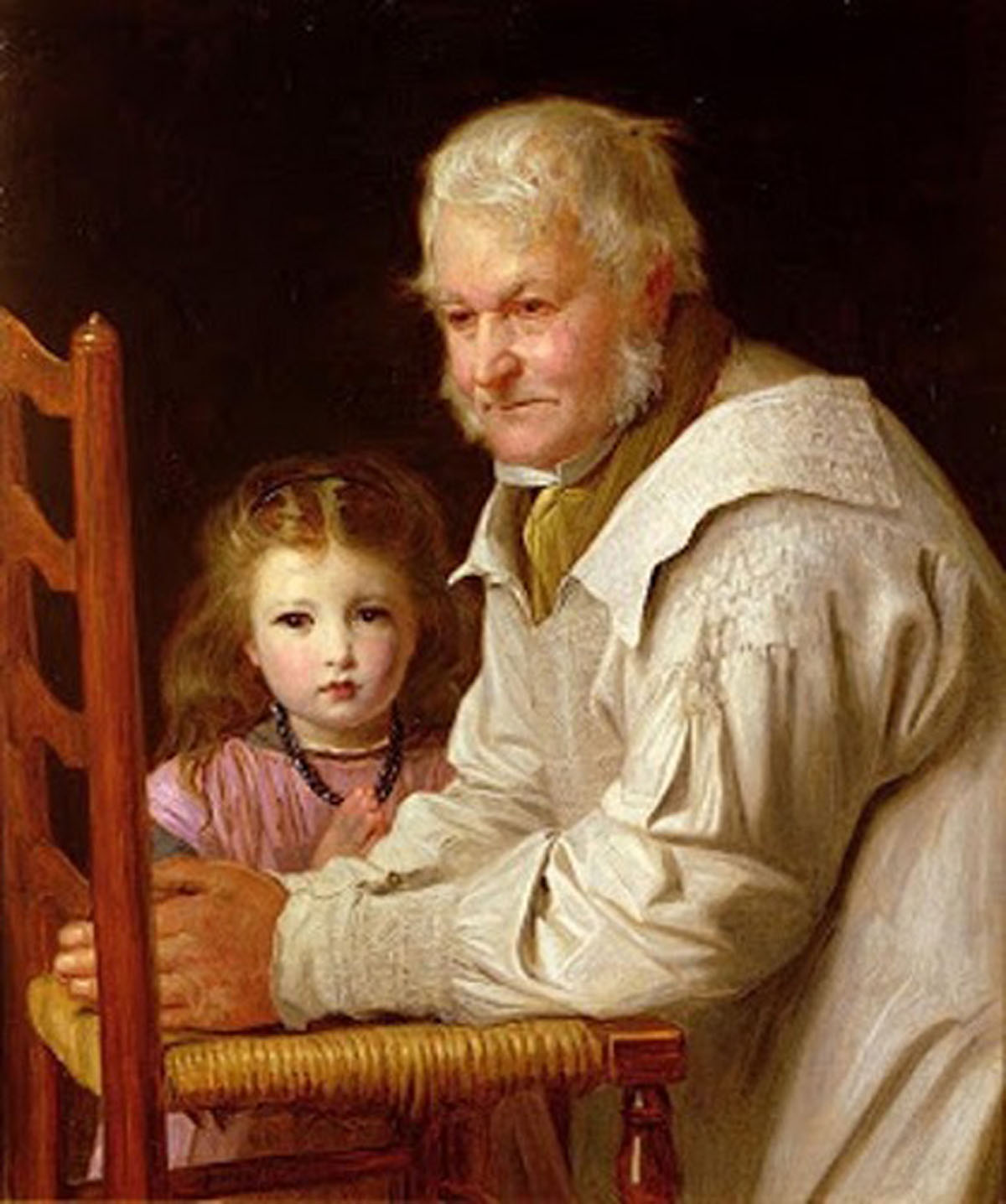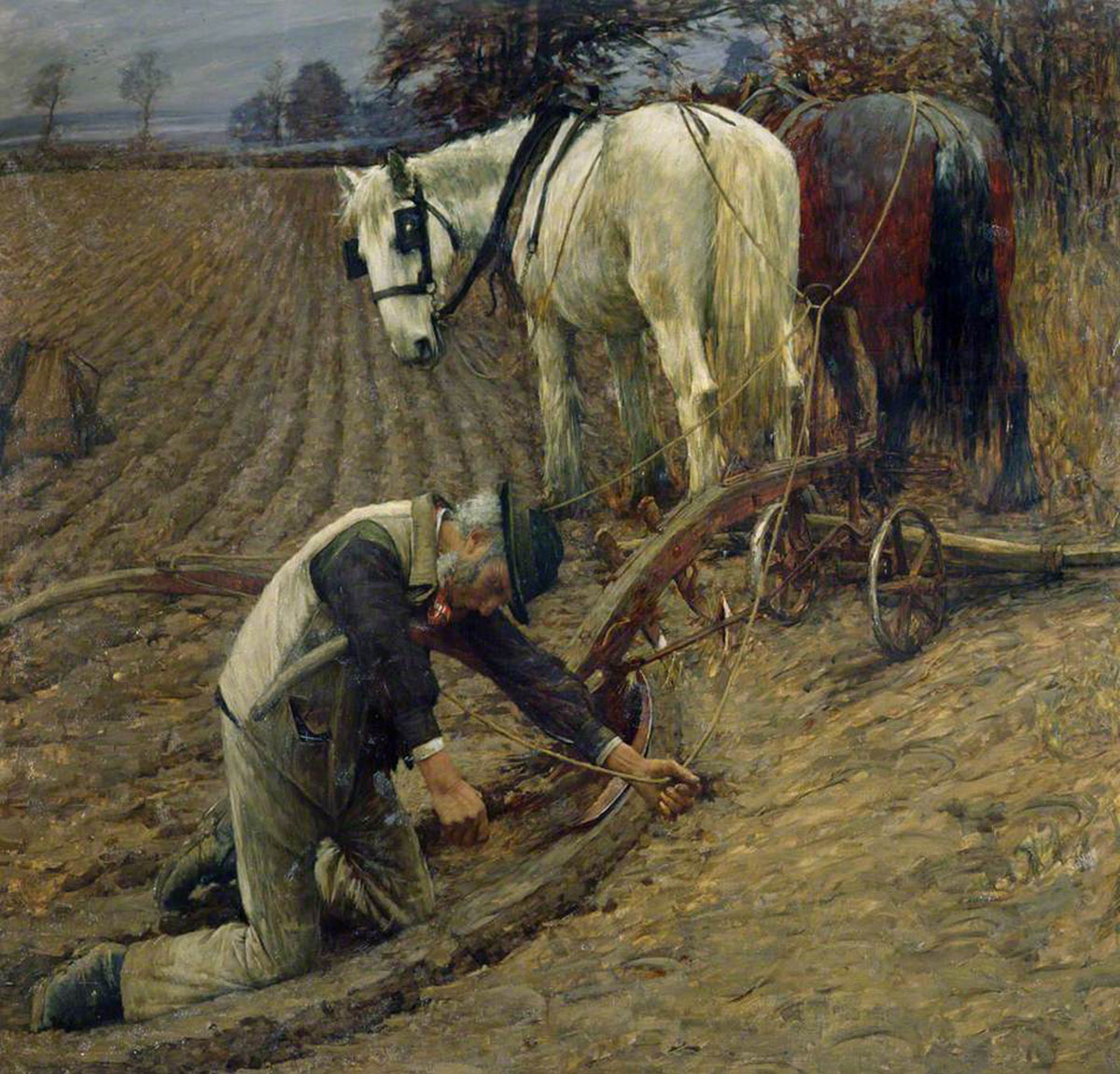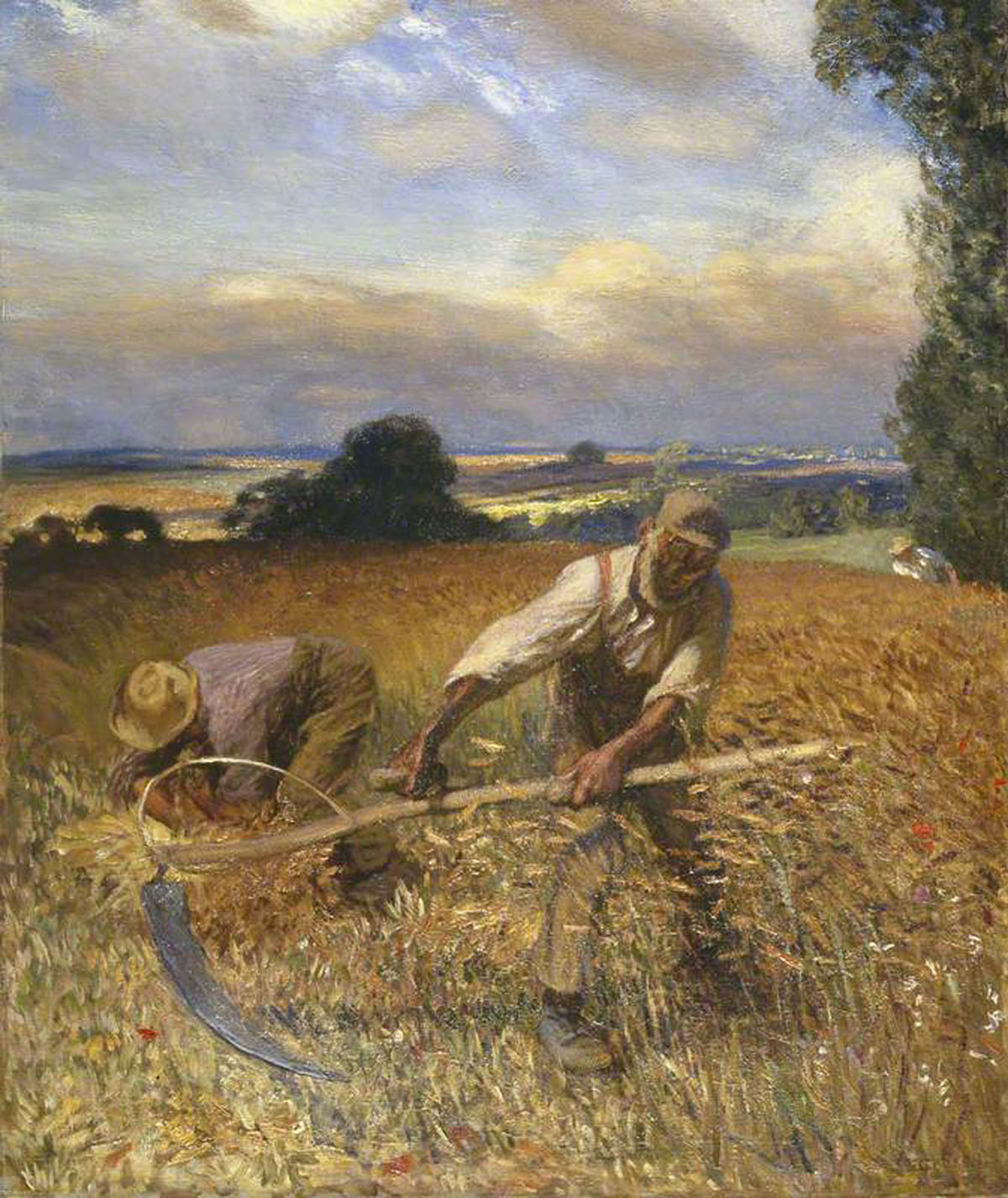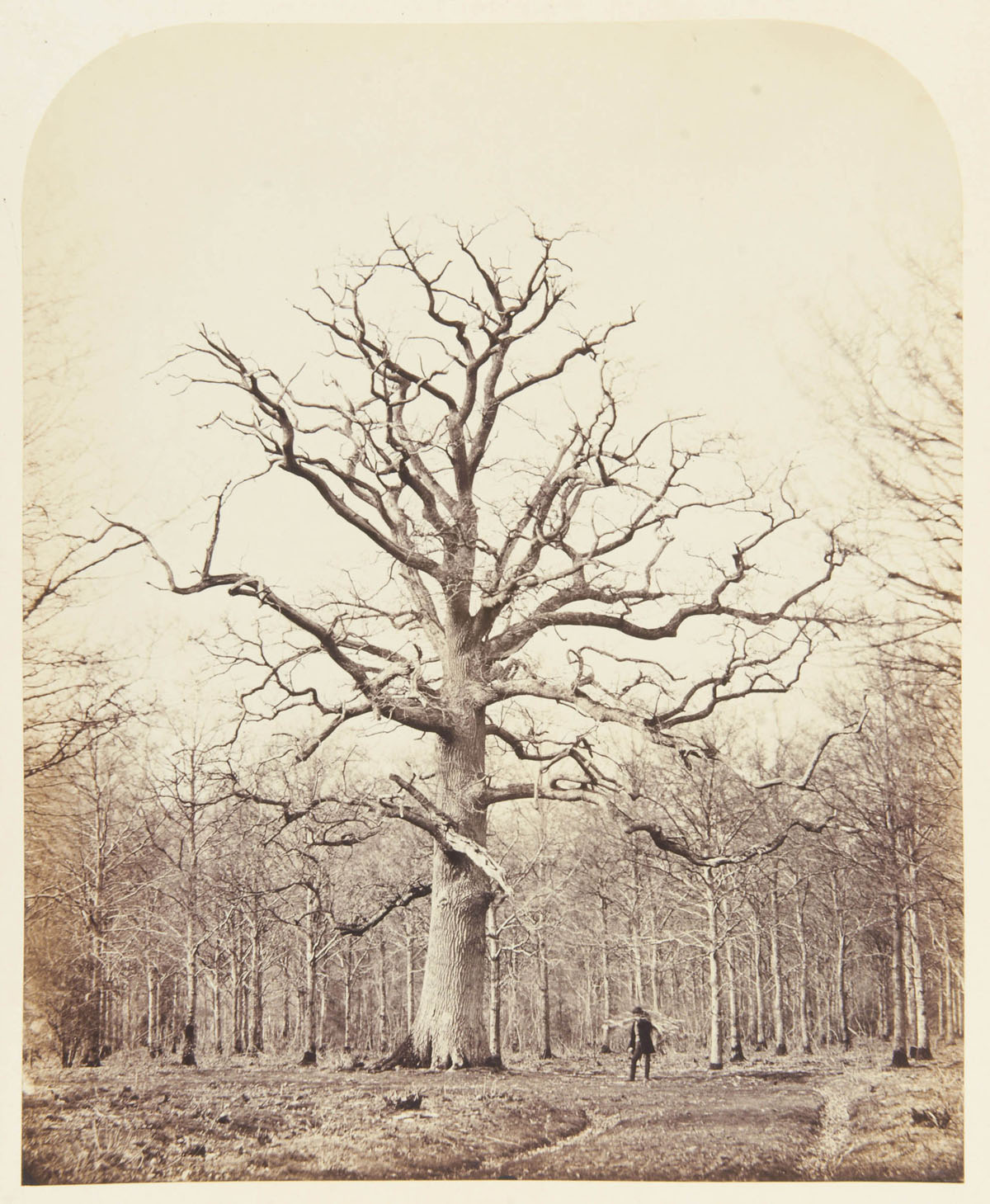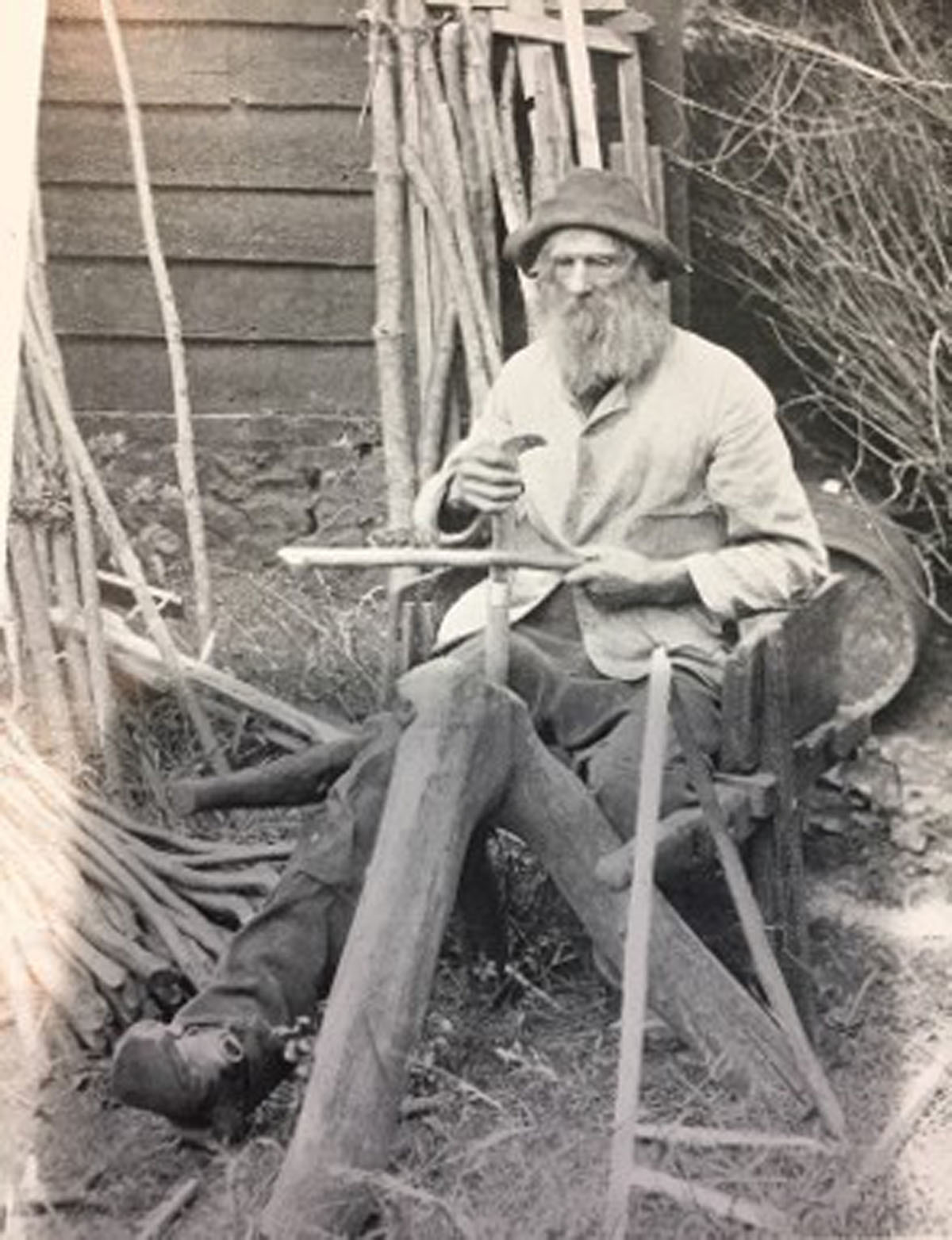In 1826 Jacob George Strutt, in his Sylva Britannica, described the Cowthorpe Oak, an ancient oak tree, as being ‘like some aged peasant, whose toil-worn limbs still give evidence of the strength which enabled him to acquit himself of the labors of his youth’.1 The tree, which no longer survives, stood next to a farmhouse, and in Strutt’s etching he shows it with suitably rustic accompaniments, an old wagon and some pigs (as well as, incongruously, a peacock) (Fig. 1). Traditionally, the oak had been seen as ‘the monarch of the woods’ and it had many royal connections, not least the story of Charles II hiding in an oak at Boscobel to escape from Cromwell’s soldiers. For Strutt, however, comparing the old oak to a peasant was as much, or even more of a compliment than comparing it to a king. The analogy he makes between an ancient tree and an aged peasant shows Strutt’s awareness of the recent tradition of praising aged, generally male labourers in poetry and depicting them in painting.
It has long been recognized that images of the rural poor, in the long nineteenth century, were often used to validate the social hierarchy.2 Both in art and in literature, men, women, and children of the cottager class were portrayed sympathetically, but the sympathy they evoked depended on an indication that they knew their place, like grateful recipients of charity from the wealthy. Their supposed virtues — industriousness, contentment, family affection, piety — were seen as grounds for national pride, symbolic of the nation as a whole. Depictions of ancient trees and aged peasants served a similar purpose. As this article will demonstrate, they appealed to those who felt nostalgic for the idea of a more settled, rural past, and emotionally attached to paternalistic values.
Strutt’s etching of the tree may be juxtaposed with Thomas Barker of Bath’s painting, Man Holding a Staff (Fig. 2). In this painting the subject wears a tattered and patched coat of some rough material over his blue jacket. His hair is dishevelled and his chin unevenly shaven. These are all signs of age and poverty. Yet he looks the viewer straight in the eye and holds his staff firmly with his left hand. The staff is from an oak tree: three very recognizable leaves remain on it, their russet colour suggesting that the man, too, is in the autumn of his life. Both the Strutt etching and the Barker painting explicitly relate the life cycle of a tree, and specifically an oak tree, to that of a human being, a man who has spent his working life in the open air, battered by the weather.
This article will show how this basic idea continued to affect the depiction of solitary trees and individual labourers over the whole of the long nineteenth century. Karen Chase has demonstrated that images of the elderly, in art and fiction, helped to form a conceptual basis for an understanding of ‘senescence’ as an integral phase of existence.3 Her discussion of the presentation of the elderly in art focused mainly on genre paintings with many figures in them. Hubert von Herkomer’s paintings of old women in the workhouse, Eventide: A Scene in Westminster Union (1878), for example, demonstrated the existence of a large class of ‘elderly poor’ with economic needs.4 In other paintings the old appear on the sidelines, performing essential tasks for the narration or acting as ‘stern arbiters’ of a scene (Chase, p. 226). In this article I will consider one particular representative of the old, the aged rustic labourer, sometimes shown as part of a family or social group, but more often on his own, like a solitary tree. Some of my examples are woodmen, whose occupation involved constant involvement with trees; others are agricultural workers, ‘rooted in the soil’ like the trees themselves.
The focus on old men raises questions about constructions of masculinity. Joanne Begiato’s new monograph, Manliness in Britain 1760–1900 has revealed the centrality of the imagined working-class male and his materiality to middle-class masculine identities. She explores a wide range of artefacts and texts, from expensive oil paintings to cheap ceramic tableware, from biographical memoirs to popular songs, to show how certain ideal forms of manliness, including the ‘Hearts of Oak’ of the soldier and sailor, were disseminated throughout society. Begiato argues that images of brawny, upright, trustworthy working-class men smoothed the transition to modernity.5 ‘For middle-class men’ the persona of the glorified worker ‘was reassuring and admirable; for working-class men he was a measure of their right to be included in the civic polity’ (p. 169). However, her book focuses on depictions of young or middle-aged men.6 Images of old men in rural settings, like images of ancient trees, spoke rather to a nostalgia for an imagined past with a stable social structure.
Oak trees are monoecious — that is, male and female flowers appear on the same tree — so you cannot have a ‘male’ oak tree. Yet oaks were generally personified as male, in contrast to more slender trees such as the ash and the silver birch, which were generally personified as female. The influential writer on the Picturesque, William Gilpin, described the ash and the oak as the Venus and Hercules of the woods.7 Oak trees were known to live to a great age. Strutt declares, for example, that the Swilcar Oak, with which he begins his book, is at least six hundred years old (p. 2). Yew trees could live even longer. Strutt reckoned the Ankerwyke Yew to be over a thousand years old, ‘the silent witness of the conferences of those brave barons who afterwards compelled King John to sign Magna Carta’ (p. 8).
The Sylva Britannica is a collection of etchings of famous trees, particularly oaks, with a commentary. It was a lavish publication, folio size, with full-size plates, financed by subscription. Many of the subscribers were landed proprietors (some of them the owners of the land on which the trees stood), and they also included Strutt’s friend, the artist John Constable. Strutt wrote the commentary himself, incorporating many historical and literary allusions. Most of the trees selected for the publication were very old, and he presented them as symbols of British history and greatness. This is the theme of his commentary to his opening plate, which describes how the role of oak trees in ‘the solemn ceremonies of the Druids’ has been superseded by ‘the ideas of British power and British independence […] inseparably connected with the British oak, in the minds of Englishmen’ due to its use in the construction of warships (p. 1).
Ancient oaks were potent symbols of national identity. They could stand for steadfastness, independence, naval power, even parliamentary democracy. In David Garrick’s popular song, ‘Hearts of Oak’ (1759), the ‘heart of oak’ applied both to the ships and to the men who sailed in them. Horace Walpole wrote in 1770 that an old tree was a symbol of liberty, which in France would be appropriated by the king: it was a symbol, then, of a country ruled by a constitutional rather than an absolute monarchy.8 For Strutt, the sight of an old oak, one that had survived the immense demand for timber for shipbuilding during the Napoleonic Wars, was, similarly, seen as a reason for patriotic pride. Strutt dedicated his volume to the 6th Duke of Bedford, saying that he associates ‘the stedfastness [sic] and independence universally attributed to the “Lord of the Woods, the long-surviving oak”’ with the characteristics of the Bedford family, ‘a family whose name will be always venerated in the annals of English history, as the champions of lawful right and well-regulated liberty.’ Lord John Russell, son of the 6th duke, was one of the prime movers in the campaign to achieve parliamentary reform through the 1832 Reform Act, which effectively preserved the power of the landed aristocracy and avoided revolution.
Trees are often considered anthropomorphically in the late eighteenth and early nineteenth centuries. Poets addressed particular trees directly, or gave them the power to speak. In Needwood Forest (1776), Francis Mundy has the Swilcar Oak speak out against the destruction going on around him.9 William Cowper addresses the subject of his poem, ‘The Yardley Oak’ (1791/2, pub. 1804), as if it were a person.10 Individual trees were given names, which could refer to their associations with human beings (such as Queen Elizabeth’s Oak) or their characteristics, as in the case of the three oaks named Majesty, Stately, and Beauty at Fredville in Nonnington, Kent. The Parliament Oak in Clipstone Park, part of Sherwood Forest, was supposed to have been the site of a Parliament held by Edward I in 1290.11 Strutt described the trees in his publication as ‘those venerable trees which seem to have stood the lapse of ages, silent witnesses of the successive generations of men, to whose destiny they bear so touching a resemblance, alike in their budding, their prime, and their decay’ (p. 1). Evidently, he found them particularly worthy of being commemorated when they were in a state of ‘decay’.
Strutt’s Sylva Britannica praises the landowners who have looked after their ancient trees and states his wish that they will continue to have stewardship of the land. Writing about Majesty, Stately, and Beauty, Strutt expresses a hope that, as ‘they are likely to stand for many centuries’ they will ‘as long continue to delight the descendants of the family by whom they are at present so highly valued, and so carefully preserved’ (p. 36). He would be pleased to know that these three trees are still standing, in an estate that is still in the same family’s ownership. They were recently the subjects of large photographic artworks by Tacita Dean.12 Conversely, a less conservative friend of Strutt’s, John Claudius Loudon, in his Arboretum et Fruticetum Britannicum, stated provocatively that, if he had just one tree in his garden, it would be a young one rather than an old one:
With the latter tree the mind is carried back to times which, though interesting in some respects, it is desirable should never recur; with the former, it is carried forward along with all the improvements which are now contemplated, or in progress, in civilised society throughout the world.13
Strutt’s commentary is anchored in a strong sense of a stable social hierarchy, with the landowners at the top, the peasants at the base. Yet he balances his praise for the landowners who nurture their trees with the suggestion that a great tree ‘seems the common property of all who raise their humble tenements within sight of its branches […] [and is] one of the delightful ornaments of nature that the poorest cottager may enjoy and be proud of’ (p. 37). The sight of an ancient tree will be enjoyed, writes Strutt, by the peasant ‘passing it on the way to his daily labors, [who] recalls, as he looks on it, the sports of his infancy round its venerable trunk, and regards it at once as his chronicler and land-mark’ (p. 1). Strutt presents the social hierarchy of rural England, then, as a system that benefits rich and poor alike.
Strutt wrote of the Tortworth Chestnut (a tree which is still standing today) that it was probably more than a thousand years old:
How is it possible […] to look upon its gigantic trunk, & widely-spreading arms, without feelings of reverence! How many, not merely generations of men, but whole nations, have been swept from the face of the earth, whilst, winter after winter, it has defied the howling blasts with its bare branches […]. Its tranquil existence, unlike that of the human race, stained by no guilt, chequered by no vicissitudes, is thus perpetually renewing itself; &, if we judge from […] the vigour of the branches which encircle the parent stem in wide profusion, may be prolonged for as many more centuries as it has already stood. (p. 29)
Strutt is overwhelmed by the vision of long centuries stretching into the future as well as the past. The tree is guiltless, vigorous and stoical in the face of winter storms. These are all qualities that poets and artists of the time find also in their constructions of aged peasants and labourers.
William Wordsworth provided a template for the stoical old man in his famous poem, ‘Michael’ (1800), which tells the story of the old shepherd whose young son, Luke, leaves home and falls into dissolute ways. Michael is
An old man, stout of heart, and strong of limb. His bodily frame had been from youth to age, Of an unusual strength.14
He has married late and had his son late in life. When Luke is about to leave, Michael says to him, ‘At eighty-four | I still am strong and hale’ (ll. 389–90). Moreover, he continues to work after Luke has left,
once again, The Shepherd went about his daily work, With confident and cheerful thoughts. (ll. 437–39)
Although he cannot bear to complete the sheepfold that they had started together, once he receives the bad news about Luke, it is clear that Michael continues to perform ‘all kinds of labour for his sheep’ (l. 458) until his death seven years later (aged, presumably, ninety-one). Like the Tortworth Chestnut, his working life included the braving of winter storms in the mountains where he lived. Michael, too, is given the context of an oak tree: when Luke is young he watches him as he sits under the ‘large old oak’ near his door, the ‘clipping tree’ under which the shepherds sheared their sheep (ll. 165, 169). Once Michael has died, only a pile of stones remains to show that he ever lived, as his world is overtaken by the forces of modernization. The clipping tree, however, lives on, and retains its traditional name, a living reminder of a vanished rural past.
A further analogy between trees and men is suggested by a series of paintings of aged labourers whose occupations involve woodland work. Around 1790, Thomas Barker painted a picture, The Woodman with His Dog, which was to become very well known, and much reproduced, in the form of prints.15 It was originally inspired by Thomas Gainsborough’s painting of the same theme (now lost), which was in turn inspired by a passage in William Cowper’s poem The Task (1785). However, Barker’s woodman is noticeably older than Gainsborough’s, with a wrinkled face and hair that is completely white. Barker shows him carrying a load of faggots, walking through a snowy landscape accompanied by his dog. He smokes a pipe and, as in Man Holding a Staff, he looks directly at the viewer. The impression the image creates is of a man who is proud and dignified, despite his age and poverty. The traveller and essayist Sir Edward Harington described meeting the model for the painting, George Kelson, while out on a walk. He wrote:
The visage of this Woodman is wonderfully expressive of his laborious occupation, rough and weather-beaten; he seems to be about sixty years of age, and, like the scene around him, appears to carry it like ‘a lusty winter, frosty but kindly’.16
For Harington, it is significant that Kelson addresses him as ‘Sir’: ‘He was too much the man, too proud of his industrious independence, and too little hacknied in the scoundrel arts of hypocrisy and servility, to deign to say Your honour!’ (p. 144, emphasis in original). Kelson tells Harington that he was initially suspicious when three gentlemen came up to him, just as he had ‘felled the stiffest beechen tree in yonder woodlands’ and asked to take his picture (p. 146). He thought they meant to rob him, so he took steps to defend himself:
I put myself in a defenceful posture […] with my hatchet upheld with both hands […]! Thus I stood unshaken as the body of a tough old tree, when wintry blasts assail its lofty branches, and make the resounding forest groan with crackling limbs! (p. 147, emphasis in original)
Harington adds the testimony of another writer, who had known Kelson for forty years, that he is ‘sober, honest, industrious, sensible, and inoffensive; a rara avis among the lower sort of people, for he believed he had never spent a shilling in a publick-house in his whole life!’ (p. 142). Like Wordsworth’s Michael and like the Tortworth Chestnut, the old man is an embodiment of virtue, particularly welcome to viewers and readers in the 1790s, when the ‘sober, honest’ character of the ‘lower sort of people’ was seen as a vital bulwark against the temptations of revolutionary ideas.
Another important woodland occupation was that of charcoal burning. In 1814 the prominent artist James Ward exhibited a double portrait of Luke and Betty Kenny at the Royal Academy (Fig. 3). The catalogue entry read as follows:
Portraits of Luke Kenny, aged ninety-six, and Kate his wife, aged eighty-eight, who have lived in the woods upwards of fifty years, and brought up a family of eight children in the hut represented, which they erect in various parts of the wood, in which they may have occasion to follow their employment, being that of burning charcoal. (no. 57)
James Ward, Portrait of Luke and Betty Kenny, 1814. Image taken from ‘Crich Parish […] History of the Kenyon Family’, which acknowledges the help of Peter Kenyon-Smith <http://www.crichparish.co.uk/webpages/kenyonhistory.html> [accessed 23 February 2021].
The couple are shown in front of their home, a conical hut made of boards and turf. The upper part of the painting is dominated by the foliage of an ancient yew tree, known as Betty Kenny’s Tree, reputed in 1909 to be two thousand years old. The painting was commissioned by Francis Hurt, the owner of Alderwasley Hall, Derbyshire, who knew the couple. According to family tradition, Luke and Kate sat, separately, for the artist in the dining hall of Alderwasley Hall, and the painting was hung in that room after its return from the Royal Academy. The sketch for the painting was completed by the artist and shown at the Academy in 1817. In the two paintings Betty is shown seated, but Luke is holding a mattock and appears to be digging with it: he is, therefore, shown as hale and hearty, still capable of work despite his great age. The age of ninety-six appears to be an exaggeration: records show that Luke Kenny (or Kenyon) was baptized in 1730, which would make him eighty-four at the time the painting was exhibited, and about eighty-one when he sat for the artist: a great age, nevertheless, for someone who had lived in a makeshift hut and worked out of doors all his life.17
Ward also painted and drew ancient trees. In 1820 he made a drawing inscribed ‘A Celebrated Ancient Tree on Lord Bagot’s Blithfield Hall Estate in Staffordshire’ (Fig. 4). This was the Beggar’s Oak, a tree that got its name from its spreading roots and branches, which enabled beggars to sit in comfort underneath it. It is included in Strutt’s Sylva Britannica and John Glover made an oil painting of it.18 In 1834 Ward exhibited an oil painting of an ancient tree — the Yeldham Oak in Essex.
In this large painting the battered old oak takes up most of the left-hand side of the canvas, as the human and animal life of the village goes on around it. Its branches are truncated and bare, yet a mass of new foliage surrounds the upper part of the trunk, suggesting both the storms that the tree has weathered and its continuing vigour. The Farmer’s Magazine listed the elements in the painting, which was effectively a compendium of the features of the rural social structure:
Over the bridge […] Mr. Newman’s hounds, huntsman, &c., are passing; and on the road […] a pedlar, and his donkey with panniers, and his dog, have just advanced a little way beyond the tree. The Great Oak Farm-house is conspicuous in the composition, and Yeldham-hall and the beautiful tower of Yeldham Church are skilfully brought in in the distance.19
The tree takes up its role, then, alongside the hall, the farmhouse, and the church. The Yeldham Oak was of local, rather than national fame. It is from an Essex newspaper that we learn that
a prominent situation has been assigned to the picture at Somerset House, where it is greatly admired on account of the extraordinary antiquity and size of the tree, as well as a work of art […]. It is emphatically an English scene.
A reviewer in the Athenaeum was less fulsome in its praise, but agreed that ‘the whole forms a scene elegant and English’.20
Old men also feature prominently in the genre painting of this period. In David Wilkie’s famous painting, The Village Politicians (1805), an old man holding a newspaper looks thoughtful as he listens to the arguments of the young hothead who sits opposite him; the other men listening round the table express excitement, but the old man remains unmoved, his hand to his chin suggesting that he is giving careful consideration to the radical ideas being expounded.21 It might be surmised that he is the representative of conservatism in this gathering. Just as the oak tree stands firm against the winter storms, then, the aged man is represented as resisting the political turbulence of the time. Wilkie’s painting caused a sensation when it was exhibited at the Royal Academy in 1806. Its most prominent admirers were the landowners Sir George Beaumont, Lord Mulgrave, Samuel Whitbread, and the Earl of Mansfield, who became its purchaser. It was widely reproduced in the form of engravings, and had a considerable impact on later genre painters in the United States and Germany, as well as in Great Britain.
Similarly, in genre painting old men are often shown as cornerstones of rural family life. Thomas Webster’s painting Good Night attracted particularly favourable reviews when it was shown at the Royal Academy in 1846 (Fig. 5). In this cottage or farmhouse interior we see three generations of a family gathering for their evening meal. At the head of the table sits the grandfather. The sickle above his head reminds us that he has cut many fields of corn in the past. He is described as a ‘hoary veteran’, the same kind of description that might be applied to an ancient tree:
Even those whose appetites have been whetted by the day’s labour, can pause with delight at the contemplation of the merry children. The expectant look of the hoary veteran, and the affection that beams through the cheerful countenance of the father, are felicitous touches of Nature. See, also, the quiet devotion with which the grandmother listens to the prayer that she has taught.22
The old man has the best position at the table and is clearly respected and looked after by his children and grandchildren. The grandmother also has an important role as teacher to the children, but she is very much in the background.
In many nineteenth-century paintings, old men are shown wearing smocks. These are not the everyday working smocks, but the embroidered smocks worn for special occasions and on Sundays. Like the wrinkled face of an old man or the rugged bark of an ancient tree, they provided a tempting subject for artists, who could dwell lovingly on their intricate decoration. In paintings smocks generally stand for the continuity of English rural life. In another painting by Thomas Webster, Sunday Evening (1858), the grandfather sits by the window, listening to the father of the family read from the Bible. The direction of the light means that the viewer’s attention is focused on him and on a group of two young children. He has an expression of deep concentration. He wears a dark green smock, in contrast to the jacket worn by his son or son-in-law. The light also draws our attention to the elaborate smocking on its sleeve.23
Other artists used old men to make a direct contrast between age and youth, and, by extension, between traditional rural practices and the modern life of a younger generation. In John Callcott Horsley’s The Contrast: Youth and Age (1839), an old man in a green smock pauses by the church door, lifting his hat in tribute, while a young girl looks quizzically at him. Horsley painted his old man from the sexton of the village where he was staying in the summer of 1839. When the painting was exhibited at the Royal Academy in 1840 Horsley included these lines in the catalogue:
Youth in its dawn, braving the thorough fare Of life with fearless foot and roving eye, Age in its humble lustre, breathing prayer Upon the threshold of eternity!24
Forty years later, James Hayllar reprised this theme in his painting, As the Twig Is Bent (1879), which also takes up the analogy between the tree and the human being (Fig. 6). In this painting an old man in an elaborately embroidered cream-coloured smock kneels in prayer, resting his forearms on a rush-bottomed chair, while a fresh-faced little girl, presumably his granddaughter, also puts her hands together to pray. She looks directly at the viewer, while the old man’s gaze is directed into the distance. Contemporary viewers would have recognized in the title the first half of the proverb, ‘As the twig is bent, so is the tree.’ This is derived from Alexander Pope’s Epistles to Several Persons (1732): ‘’Tis education forms the common mind, | Just as the twig is bent the tree’s inclined.’ The overall theme is, then, the importance of early influences on the child, but the title implies that the girl is a ‘twig’ and the old man the fully grown tree.
James Hayllar exhibited at the Royal Academy and the Royal Society of British Artists for over forty years, and trained his four daughters to paint.25 From 1876 the family rented a large house, Castle Priory, on the banks of the Thames at Wallingford, and used local villagers as their models. They were essentially, then, taking on the role of the village squire and his family themselves. The old man in the cream smock appears again in The Invalid (c. 1889), where he is shown looking after his wife. She sits in a patchwork chair with an array of medicine bottles on a table by her side, while he pours liquid into a bowl, a look of concern on his face. We see him yet again in a curious painting, Deputation of Villagers Presenting a Wedding Gift (1880), where he is accompanied by another old man in a green smock, similarly embroidered (Fig. 7). In this painting the villagers stand in the hall of a country house, respectfully donating a silver object to a young woman, who sits in an armchair in her fashionable dress, her velvet slippers resting on a Persian rug. A young woman in a black dress — perhaps a governess — holds the gift. In this context the old men in smocks clearly emphasize and validate a paternalistic social structure.
The old men in these paintings are not working. However, late nineteenth-century paintings of agricultural work often focus on old men labouring in the fields. This partly reflects current practice: commentators remarked that the young men were taking up employment opportunities in the towns and cities, leaving the farms to be worked by the old. It was also the case that some of the traditional skills, like the ability to cut corn with a scythe, were largely practised by older labourers, since their function was steadily being taken over by machinery. In addition, the tendency of French artists such as Jean-François Millet, and then Jules Bastien-Lepage and Louis Lhermitte, to create poetic evocations of the hardships of rural life meant that older models were much in demand. To modern eyes some of them look much too old to be working — but it was widely acknowledged that the manual labour of the fields and the effects of poverty could make a man of fifty look more like a man of seventy. George Clausen made a series of drawings of a woodcutter known as ‘Old Lawrence’ who posed for the artist, dressed in a smock and a felt hat. These were used as the basis for a portrait of the man, titled An Old Woodman and exhibited at the Royal Academy in 1885.26 The painting itself is untraced, but a contemporary photograph of it shows a man holding a billhook in one hand and a bunch of sticks in the other, with a wrinkled neck and stubbly chin, his eyes looking wistfully into the distance. We learn from one of the reviews that his smock was green: the critic of the Athenaeum described him as ‘a South-Saxon in a green smock-frock, holding a bill-hook […] a capitally painted, vigorously expressive figure’.27 Here the term ‘vigorous’ refers to the artist’s technique, but the critic may also have been thinking of the vigour of the woodman himself.
George Clausen’s Ploughing (1889) features a handheld plough being drawn by two horses across a dreary landscape. A young boy leads the team, but it is an elderly man who does the more physically challenging job as he walks behind, holding the handles of the plough. Six years later Henry Herbert La Thangue developed this theme in a shocking picture, The Last Furrow (Fig. 8). Here we see an old man who has collapsed in the corner of the field, just as his horses have completed their final section of ploughing. He has fallen onto the wooden plough handle, the rope which has been guiding the horses still in his hand. One critic would have preferred to see the ploughman still at work:
An old ploughman, who has tramped in his day many a mile after the plough with uneven stride along the upturned furrow, has reached his last turn, and falls dead over the plough-handles. The quiet horses wait, and one turns its head to see why no further orders are given. The furrowed earth, the horses, the plough are carefully painted and foreshortened; the old man’s figure scarcely explains itself, however. The appeal, of course, is to the public, to those who love such sentiment; but the picture would have been finer — at least in one opinion — had the old labourer been depicted plodding patiently at his task.28
‘Plodding patiently at his task’ is what labourers do in other paintings such as Clausen’s Ploughing of 1889, and clearly it is also what La Thangue’s labourer has done, until he can work no more. He has died ‘in harness’ as if he were a horse, the line of the plough handle across his chest suggesting an analogy with the leather collars that attach the horses to the plough. His shock of white hair echoes the colour of the nearest horse, which turns round, implying the sympathy viewers should feel for the poor ploughman. Like a tree struck down in a storm, he slumps onto the earth from which he appears to have grown.
To modern eyes an image such as this makes a strong case for the introduction of an old age pension, which was under discussion at the time, and it was certainly meant to arouse sentimental sympathy. At the same time the painting could be seen as part of the same tradition of the vigorous old peasant who works to maintain his independence right up to the end of his life, like Wordsworth’s Michael and the charcoal burner Luke Kenny. Charles Booth, who campaigned for the introduction of the pension, stressed that it should not be seen as another form of charity, that might seem to indicate a loss of independence and self-respect:
We must […] disregard the idea that any old man would be above drawing his pension, as it is of the essence of the proposal that the pensions should be paid in an honourable way, so as to be absolutely free from any poverty qualification or stigma whatever.29
Booth seems to have had in mind some of the stalwart elderly poor men who are so often celebrated in the art and literature of the time.
The theme of nostalgia for the rural past became stronger in George Clausen’s later works. In 1909 — the year the first old age pensions were paid — he exhibited Interior of an Old Barn and The Old Reaper (Fig. 9) at the Royal Academy. Both paintings have seductive charms of atmosphere, impressionist brushstrokes, and bright colour that were lacking in the more documentary portrait of the woodman. The relationship between trees and men is implicit in these paintings: the ancient barn is made entirely of wood, the reaper grasps the wooden handles of a scythe. The old barns with their doors large enough to take loaded wagons were becoming obsolete at this time, as threshing machines took over the work that would previously have been done by hand during the winter, and many were pulled down to make way for more modern buildings. Scything, too, was becoming a rarer sight, generally used only for the headland of a field, where overhanging trees or damp patches impeded the progress of the reaping machine. Around this time a rural commentator remarked, ‘the chances of watching the survival of a vanishing art, the height of an accumulated tradition of skill, that dies without an heir tomorrow, grows less and less with every haytime that comes around’ (McConkey, p. 150). The old reaper looks barely strong enough to hold the heavy scythe; his frame has been weakened by many years of hard physical labour, but his spirit remains undimmed as he continues to practise a dying skill.
In nineteenth-century photography, too, images of ancient trees, and old labourers, are common. The wrinkled trunk of an old tree, like the wrinkled face of an old man, responded well to the techniques of early black-and-white photography. A volume titled The History of Windsor Great Park and Windsor Forest was published in 1864, illustrated with photographs of ancient trees by the Earl of Caithness and William Bambridge. Queen Anne’s Oak shows a tree that was 450 years old (Fig. 10); an old woodcutter with a load of faggots on his back stands beside it to give a sense of scale. Another photograph is titled The Veterans of the Forest.30 All the trees were photographed in winter, when their skeletal structures were apparent. This was partly for technical reasons: with long exposure times, patches of light on foliage would expand until they looked as if there had been a snow shower. The effect is to make the trees look even more heroic for surviving so many storms.
It was often remarked that isolated trees, and trees that were allowed to grow to a great age, had much more individuality, more character, than trees that grew all together in a forest. An article published in Country Life in 1901 argued that the same was true of human beings. It was titled ‘Scottish Village Types’ and consisted of photographs of poor people from the Orkney Islands, including a blacksmith, a gypsy woman, and a fisherman. All were old. The accompanying text claimed that modern urban life whittled away all individuality, especially in the ‘working classes’:
Our working classes […] have the same gardens and grow the same vegetables, go to the same public-houses, swear the same stupid oaths […], share the same Bank Holiday pleasures, and, in fact, have ceased to be men, and are mere items — bricks in the social structure.31
In contrast, the writer remarks, it is refreshing to wander in remote country districts and encounter people who have developed their own peculiarities. The fisherman, for example — a man with a long white beard — is ‘as sturdy and manly a type as you will find in the British Islands’ (p. 428).
In the following issue there was a photograph in the ‘Correspondence’ section of James Minns, or ‘Rough Jimmy’, claimed to be the oldest woodcutter in England (Fig. 11). At the age of seventy-five, his eyesight was failing, so he had given up felling trees, yet he continued to make a living by splitting branches to be used for thatching stacks. When the local authorities decided to send him to the workhouse, the local squire stepped in and offered to provide a free cottage and a shilling a week for the rest of his life. Minns himself seems to have accepted the paternalistic charity offered by the squire, although he was reportedly adamant that he would not go to the workhouse: ‘“Go into the workhouse! No, I’d sooner lie down and die by the side of the road, and I’d do it, too,” this with a decided shake of the old grey head.’32 In the photograph James Minns sits in a chair surrounded by evidence of woodland work, a stick in one hand and a billhook in the other. The editor commented, ‘it is extremely interesting and in a way, pathetic, to see the photograph of this toil-worn rustic, and we shall be glad at any time to receive pictures equally marked by character and individuality’ (p. 479). This was just one of many images of old labourers in the late nineteenth and early twentieth centuries. Photographers recorded old rural labourers, as they recorded old practices such as reaping by hand and ploughing with horses. These subjects also became popular for postcards.
Rural nostalgia is a potent theme in the novels of Thomas Hardy, and he, too, takes up the idea of the analogy between rural labourers and trees. In Far from the Madding Crowd (1874) the name given to Gabriel Oak implies the qualities of his character: he is steadfast, reliable, and independent, like an oak tree. In The Woodlanders (1887) the analogy between the life cycles of human being and tree is given a particularly memorable form. A pivotal event in the book is the death of old John South, the woodman, whose demise means that Giles Winterbourne loses his home and consequently his chance of marrying Grace Melbury. John South believes that a tree planted on his property when he was born was in danger of falling on his cottage and killing him. As his daughter Marty explains:
He says that [the tree] is exactly his own age, that it has got human sense, and sprouted up when he was born on purpose to rule him, and keep him as its slave. Others have been like it afore in Hintock.33
Giles cuts the tree down, but South is so shocked when he sees it has gone that he has a fit and expires later the same day. In this case, then, the tree exactly mirrors the man’s life in its budding, its prime, and its decay.
Another character in The Woodlanders is Robert Creedle, Giles’s co-worker. He is an old man whose smock-frock covers a military jacket and hunting boots, suggesting an image similar to that of Barker’s Man Holding a Staff, with his several layers of clothing. However, where Barker’s image is serious and dignified, Hardy’s description takes on a comic edge:
To have completely described him it would have been necessary to write a military memoir, for he wore under his smockfrock a cast-off soldier’s jacket that had seen hot service, its collar showing just above the flap of the frock; also a hunting memoir, to include the top-boots that he had picked up by chance; also chronicles of voyaging and ship-wreck, for his pocket-knife had been given him by a weather-beaten sailor. But Creedle carried about with him on his uneventful rounds these silent testimonies of war, sport, and adventure, and thought nothing of their associations or their stories. (p. 24)
The description of Creedle plays on the reader’s knowledge of images of aged labourers and makes gentle fun of depictions of them as wise and steadfast. Creedle is a good man, but the histories he enshrines, the ‘silent testimonies’ (a phrase strikingly similar to Strutt’s ‘silent witnesses’) are not his own: he thinks nothing of the stories his clothes and boots suggest, because he does not know them.
The analogy between old men and trees occurs repeatedly throughout the long nineteenth century. This article has considered some very specific examples, including James Ward’s portraits of Luke and Betty Kenny (1814), Jacob George Strutt’s commentary to his Sylva Britannica (1826), James Hayllar’s genre painting, As the Twig Is Bent (1879), and Hardy’s novel The Woodlanders (1887). In other images, and in Wordsworth’s poem ‘Michael’ (1800), the links are more subtle. Old men are described in terms that could equally well apply to trees: Michael, for example, is ‘stout of heart, and strong of limb’. The agricultural labourers depicted by George Clausen and Henry Herbert La Thangue seem to grow out of the soil, and to return to it when they die, just like trees. Their lives are dominated by wood — in the trees they cut for firewood, the handles of their ploughs and scythes, the wooden barns and wagons. Just as the ancient trees bear witness to the past, so too do the embroidered smocks worn by many of the old men in the paintings, and the vanishing skills they practise.
The cult of the aged labourer, like that of the ancient tree, had strong appeal for those who were nostalgic for an apparently more settled rural society with a hierarchical social structure. Both trees and labourers were seen as repositories of history, reminders of past naval victories and of peaceful reform over the centuries, and exemplars of the virtues of stoicism, steadfastness, and independence — ‘manly’ virtues suitable for an older age group. The images show continuity over the long nineteenth century: James Minns in 1901 is just as proud and independent as George Kelson in 1790 or Luke Kenny in 1814, and just as connected, practically and symbolically, to the trees that provide his livelihood. In the later images, however, there is a greater emphasis on the pathos of old age, appropriate for a time when practical measures, in the shape of an old age pension, were being taken to alleviate some of its effects among the poor.
Notes
- Jacob George Strutt, Sylva Britannica; or, Portraits of Forest Trees, Distinguished for Their Antiquity, Magnitude, or Beauty (London: Strutt and Colnaghi, 1822), p. 25. The publication date on the title page is 1822 but the date on the frontispiece is 1826, so it must have been published in 1826 or later. [^]
- See, for example, John Barrell, The Dark Side of the Landscape: The Rural Poor in English Painting 1730–1840 (Cambridge: Cambridge University Press, 1980); Ann Bermingham, Landscape and Ideology: The English Rustic Tradition, 1740–1860 (Berkeley: University of California Press, 1992); and Christiana Payne, Toil and Plenty: Images of the Agricultural Landscape in England, 1780–1890 (New Haven: Yale University Press, 1993). [^]
- Karen Chase, The Victorians and Old Age (Oxford: Oxford University Press, 2009), p. 2. [^]
- Chase, p. 223. The painting is in the Walker Art Gallery, Liverpool. [^]
- Joanne Begiato, Manliness in Britain 1760–1900: Bodies, Emotion, and Material Culture (Manchester: Manchester University Press, 2020), esp. pp. 168–202. [^]
- However, see Begiato, pp. 92–93, where some examples of hale old men are given, including an illustration of the lifeboat coxswain Joseph Cox, who saved over two hundred lives during his career. See also, Michael Brown and Joanne Begiato, ‘Visualising the Aged Veteran in Nineteenth-Century Britain: Memory, Masculinity and Nation’, in Martial Masculinities: Experiencing and Imagining the Military in the Long Nineteenth Century, ed. by Michael Brown, Anna Maria Barry, and Joanne Begiato (Manchester: Manchester University Press, 2019), pp. 102–36. [^]
- William Gilpin, Remarks on Forest Scenery, and other Woodland Views, 2nd edn, 3 vols (London: Blamire, 1794), I, 35. [^]
- Horace Walpole, On Modern Gardening (London: Brentham Press, 1975), p. 31. [^]
- [Francis Mundy], Needwood Forest (Lichfield: Jackson, 1776), p. 42. [^]
- See Christiana Payne, Silent Witnesses: Trees in British Art, 1760–1870 (Bristol: Sansom, 2017), p. 92. [^]
- Hayman Rooke, Descriptions and Sketches of Some Remarkable Oaks in the Park at Welbeck (London: Nichols, 1790). [^]
- Now held by Tate, London. [^]
- J. C. Loudon, Arboretum et Fruticetum Britannicum; or, The Trees and Shrubs of Britain, 8 vols (London: Longman, Orme, Brown, Green, and Longmans, 1838), I, 201. [^]
- ‘Michael’, in William Wordsworth, Selected Poems, ed. by Walford Davies, Everyman’s Library edn (London: Dent, 1975), p. 63, ll. 42–44. [^]
- See Iain McCallum, Thomas Barker of Bath: The Artist and His Circle (Bath: Millstream Books, 2003), pp. 30–39. For a reproduction of the painting, see Payne, Toil and Plenty, p. 79. [^]
- Edward Harington, A Schizzo on the Genius of Man: In Which […] the Merit of Mr. Thomas Barker […] Is Particularly Considered (Bath: Cruttwell, 1793), pp. 141–42, emphasis in original. The passage in italics is quoted from Shakespeare’s As You Like It, II. 3: ‘Therefore my age is as a lusty winter, | Frosty, but kindly.’ [^]
- This information comes from ‘Crich Parish […] History of the Kenyon Family’, which acknowledges the help of Peter Kenyon-Smith <http://www.crichparish.co.uk/webpages/kenyonhistory.html> [accessed 24 February 2021]. [^]
- The painting by John Glover is reproduced in Payne, Silent Witnesses, p. 91, fig. 40. [^]
- ‘The Yeldham Oak’, Farmer’s Magazine, May–December 1834, p. 254. [^]
- ‘County News’, Essex Standard, 24 May 1834, [p. 3], emphasis in original; ‘Fine Arts: The Exhibition of the Royal Academy’, Athenaeum, 10 May 1834, pp. 355–56 (p. 356). [^]
- For this painting, see David H. Solkin, Painting Out of the Ordinary: Modernity and the Art of Everyday Life in Early Nineteenth-Century Britain (New Haven: Yale University Press, 2008), pp. 7–35. [^]
- ‘Fine Arts’, Athenaeum, 16 May 1846, pp. 502–04 (p. 503). [^]
- For this painting, see Christiana Payne, Rustic Simplicity: Scenes of Cottage Life in Nineteenth-Century British Art (Nottingham: Djanogly Art Gallery/Lund Humphries, 1998), p. 14. [^]
- Victoria and Albert Museum, ‘The Contrast: Youth and Age’ <https://collections.vam.ac.uk/item/O17372/the-contrast-youth-and-age-oil-painting-john-callcott-horsley/> [accessed 23 February 2021]. [^]
- For James Hayllar, see Christopher Wood, ‘The Artistic Family Hayllar, Part I: James Hayllar’, Connoisseur, April 1974, pp. 266–73. [^]
- Kenneth McConkey, George Clausen and the Picture of English Rural Life (Edinburgh: Atelier Books, 2012), pp. 65–66. [^]
- ‘The Royal Academy’, Athenaeum, 13 June 1885, pp. 765–66 (p. 765). [^]
- ‘The Royal Academy’, Glasgow Herald, 4 May 1895, p. 7. [^]
- Charles Booth, Pauperism: A Picture and the Endowment of Old Age: An Argument (London: Macmillan, 1892), p. 200. [^]
- William Menzies, The History of Windsor Great Park and Windsor Forest (London: Longman, Green, Longman, Roberts, and Green, 1864), illustrations facing pp. 39 and 23. [^]
- ‘Scottish Village Types’, Country Life, 5 October 1901, pp. 426–28 (p. 426). [^]
- Letter to the editor, Country Life, 12 October 1901, p. 479. [^]
- Thomas Hardy, The Woodlanders, ed. by Dale Kramer (Oxford: Oxford University Press, 2005), p. 93. [^]

